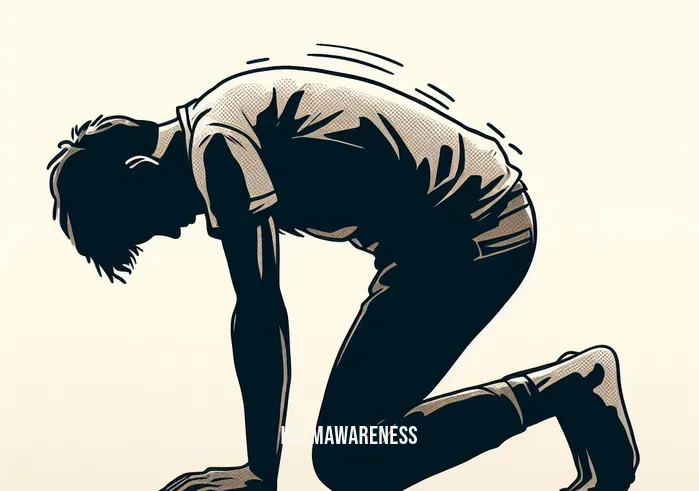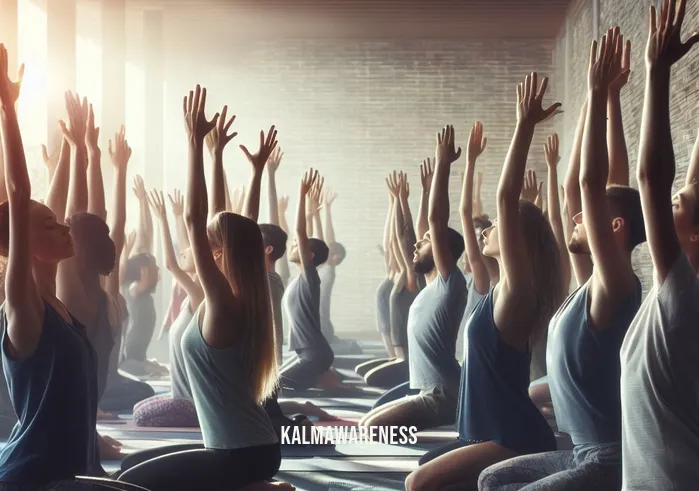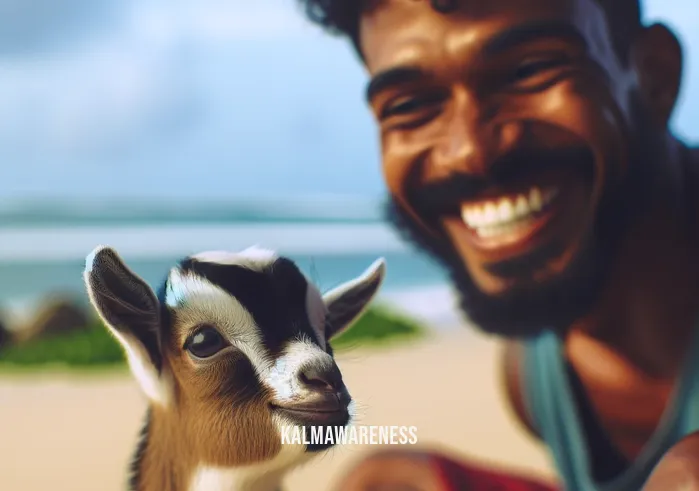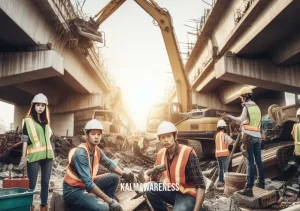Does Putting Your Hands Above Your Head Help You Breathe: Breathing, Posture, and Well-being
In our quest for improved health and well-being, breathing often takes a back seat, overshadowed by trendy diets and exercise regimes. Yet, mastering the art of breathing holds the promise of profound transformative effects. Many have asked, “does putting your hands above your head help you breathe?” This seemingly simple gesture can have profound implications on our breathing patterns, posture, and overall well-being. This introductory chapter offers a glimpse into the vast world of breathwork and prepares the reader for a deeper dive in the subsequent segments.
The Mystery of Breathing Techniques
Across various cultures and traditions, breathing techniques have held a place of reverence. From the ancient Pranayama practices of India to contemporary holistic methods, the focus remains the same: harnessing the power of breath. For instance, the Dirgha technique emphasizes deep, three-part breathing, illuminating the interconnectedness of different parts of our lungs and diaphragm. Such methods not only optimize oxygen intake but also influence our mental state, ushering in tranquility and focus.
On the other hand, intriguing techniques such as testicle breathing and breathing into your balls draw from Eastern philosophies, underscoring the connection between breath and the body’s energetic systems.
The Posture Paradigm
Our posture is intricately linked with our breathing patterns. A slouched posture can restrict the diaphragm, limiting the depth of our breath. Conversely, an erect posture promotes deeper and fuller breaths. This brings us to the question at hand: does raising your arms above your head help you breathe? By lifting our arms, we expand the chest cavity, making it conducive for the lungs to expand. It’s an instinctive gesture; think of moments when you’ve tried to catch your breath after a sprint. But more than a momentary relief, this gesture, when incorporated systematically, can reshape our breathing habits.
A Glimpse into Pranayama
Prana means life force, and Yama signifies control. Pranayama, a pillar of yoga, involves controlling and directing this life force through deliberate breathing techniques. Diverse in their approach, some Pranayama practices like vase breathing focus on breath retention, while others, such as feather breathing, emphasize gentleness.
Well-being Beyond Breath
Breathwork, undeniably, forms a cornerstone of well-being. Yet, holistic health encompasses more. Mindfulness practices such as morning meditation for anxiety and introductory courses like meditation for beginners by Jack Kornfield complement breathwork, offering tools to navigate life’s challenges. While breathing techniques like nature breathing connect us to the world outside, meditation anchors us within.
Setting the Course
The exploration of breathing and its influence on our well-being is as vast as it’s profound. Whether you’re delving into the face yoga method 28-day challenge or understanding the nuances of the breathing ratio, the journey promises insights and transformative experiences. Breathing is not merely an act of survival; it’s an art, a science, and a doorway to holistic health.
As we proceed, expect an in-depth exploration of these breathing techniques, their roots, benefits, and ways to integrate them into daily life. From debunking myths to presenting scientific evidence, the subsequent chapters promise a comprehensive understanding of the world of breath.
Intrigued? Join us in the next chapter as we delve deeper into the intricate dance of breath and life. Your journey to better health and mindfulness is just a breath away. Continue reading.

Elevating Breath: The Mechanics Behind Hands and Head Alignment
The age-old adage, “does putting your hands above your head help you breathe?” is more than just a saying. Rooted in physiological truths, this practice can transform our breathing and overall well-being. As we dive deeper into this chapter, we’ll shed light on the mechanics, benefits, and variations of this gesture, accompanied by structured insights and a comprehensive table.
The Physiology Behind the Gesture
When we raise our arms above our head, several physiological shifts occur:
- Thoracic Expansion: The rib cage elevates and widens, allowing for better lung expansion.
- Diaphragmatic Release: The diaphragm descends more efficiently, facilitating a deeper inhalation.
- Reduced Compression: The internal organs, especially those below the diaphragm, experience less compression, enhancing airflow.
Varied Techniques and Their Benefits
- Simple Arm Raise: Just lifting your arms can stimulate better breath.
- Benefit: Enhances immediate oxygen intake.
- Stretching Backwards: Combining the arm raise with a gentle backward bend can stimulate the back of the lungs.
- Benefit: Helps in activating lesser-used parts of our lungs.
- Intertwining Fingers: Post raising the arms, intertwining the fingers and stretching can further the stretch.
- Benefit: Enhances chest cavity volume, facilitating deeper breaths.
Notably, certain methods like the candle and flower breathing emphasize conscious inhalation and exhalation, which can be combined with the aforementioned techniques for augmented results.
A Comparative Glance: Breathing with and without Arm Raising
| Criteria | Without Arm Raising | With Arm Raising | Notes |
|---|---|---|---|
| Lung Capacity Utilized | 70-80% | 90-100% | Raising arms allows for fuller lung utilization. |
| Muscle Engagement | Primarily diaphragm | Diaphragm, intercostals, and upper body muscles | Greater muscle engagement aids better breath control. |
| Oxygen Intake | Average | Increased | Better oxygen intake aids in improved cellular function. |
| Ease of Breathing | Can be restrictive | Easier and deeper | Especially beneficial post-strenuous activities. |
| Postural Impact | Can lead to slouching | Encourages erect posture | Aligning hands and head can correct posture over time. |
Common Misconceptions
- Only for Athletes: While athletes often use this gesture post an intense session, it’s beneficial for everyone.
- Temporary Relief: Beyond immediate relief, consistent practice can lead to lasting respiratory benefits.
- A Replacement for Breathing Exercises: While effective, it should complement other practices like conscious connected breathing and not replace them.
Embracing the Practice: Tips for Beginners
- Start with short durations, gradually increasing as comfort grows.
- Combine with mindful breaths to maximize benefits.
- Ensure you’re not overstretching; comfort is key.
Towards a Breathful Future
Understanding the science and benefits behind raising our hands above the head opens doors to improved respiratory health. As we adapt this simple yet impactful practice, we pave the way for optimized breathing, laying a foundation for enhanced physical and mental health.
As our exploration deepens, in the next chapter, we will journey into the world of advanced breathing techniques and their transformative potential. Continue reading, for a breath of fresh insights awaits.

Breathing Hope: Elevating Hands, Lifting Spirits
Throughout history, humans have looked to various techniques to enhance their physical and mental well-being. Among these, the practice of raising hands above the head to promote better breathing stands out not just for its physiological benefits but also its potential to inspire. How, one might ask? Let’s explore the deep wells of hope and inspiration embedded in this simple yet profound act.
The Power of Elevated Breathing in Daily Life
Anna, a 28-year-old professional, often found herself weighed down by the pressures of her job. Stress was her constant companion, affecting both her mental peace and physical health. It was during a morning meditation for anxiety that she first learned of the practice of raising her hands above her head to breathe better. She recounts:
“The first time I tried it, it felt like a weight was lifted off my chest. Quite literally, I could breathe better, think clearer, and suddenly, the world wasn’t as daunting.”
This practice, drawing inspiration from age-old wisdom, serves as a beacon of hope for many like Anna, helping them navigate life’s challenges with a breath of fresh air.
Words that Resonate: Quotable Insights
Lao Tzu: “When I let go of what I am, I become what I might be.” Aligning with our natural breathing, especially with elevated hands, is akin to letting go of restrictions and embracing our potential.
Rumi: “The breeze at dawn has secrets to tell you. Don’t go back to sleep.” This echoes the feeling many describe when they breathe deeply with raised hands—a sense of awakening.
Thich Nhat Hanh: “Feelings come and go like clouds in a windy sky. Conscious breathing is my anchor.” This aligns with the grounding nature of elevated breathing.
Leonardo da Vinci: “Simplicity is the ultimate sophistication.” Elevating hands for better breathing epitomizes this, being a straightforward yet powerful method.
Breathing Hope into Communities
In the remote village of Mediterra, elders teach youngsters about nature breathing, a practice that emphasizes syncing one’s breath with nature’s rhythms. Elevating hands above the head while practicing this has become an integral part of their community rituals.
Maria, an elder in the village, shared:
“For us, raising our hands while breathing isn’t just about the physical act. It’s a symbol—of surrender, of receiving blessings from the skies, of being one with the world around us. It has knitted our community closer, inspiring hope and unity.”
Joining Hands with Traditional Practices
Another dimension of this practice finds its roots in Pranayama, an ancient yogic breathing technique. The Dirgha method, for instance, encourages deep, three-part breaths, which can be accentuated further by elevating the hands.
Samir, a renowned yoga practitioner, describes his experience:
“Integrating the act of raising my hands above my head while practicing Dirgha has been transformative. It’s as if the universe and I are in a harmonious dance, each breath syncing with cosmic rhythms.”
Breathing into Tomorrow
The narrative around raising our hands to breathe better isn’t confined to its physiological merits. It’s a tale of hope, of communities coming together, of ancient wisdom merging with modern practices. As we delve further into the myriad dimensions of breathing in our next chapter, we’ll explore how this simple act, deeply rooted in tradition and contemporary needs, can be the foundation for holistic well-being. Let’s continue our journey, for there’s much more to inspire.

Elevated Insights: Unpacking the Breathing Technique
From its origins to its holistic benefits, the act of raising hands above one’s head to enhance breathing is more than just a physical maneuver. It’s an intertwining of ancient wisdom, physiological science, and a symbol of surrender and openness to the universe. Let’s dissect this multifaceted practice, exploring its nuances and how it touches different facets of our lives.
Physiological Breakdown: How It Works
Rib Cage Expansion: When hands are raised, the rib cage expands, offering the lungs more space to inflate.
Optimal Diaphragmatic Movement: The diaphragm, a chief muscle in breathing, can descend more freely, facilitating deeper inhalations.
Improved Oxygen Intake: With deeper breaths comes increased oxygen intake, vital for cellular function and overall vitality.
Reduced Strain on Accessory Muscles: Elevating the hands can reduce the strain on accessory breathing muscles, making the process more efficient.
Symbolism and Spiritual Connections
Gesture of Receptivity: In many cultures, raising hands is seen as a gesture of receiving blessings or tapping into cosmic energy.
Unity with Nature: As with practices like nature breathing, raising hands can symbolize one’s unity with the environment, echoing sentiments of being in tune with the universe.
Surrender: In various spiritual practices, this gesture signifies surrender, an act of letting go and embracing the higher powers.
Societal Perceptions and Acceptance
Modern Yoga: Elevating hands has found its way into contemporary yoga classes, especially with practices like the Face Yoga Method 28 Day Challenge.
Athletic Training: Many athletes incorporate this into their training routines, recognizing the benefits it offers in terms of enhanced oxygen intake.
Therapeutic Practices: Respiratory therapists and certain meditation practices advocate for this method to help patients or practitioners achieve better breathing.
Potential Challenges and Misconceptions
Physical Restrictions: Not everyone might find it comfortable or feasible to raise their hands frequently due to physical constraints.
Overemphasis on Technique: While the technique offers benefits, it’s essential to understand that it’s just one of many methods to improve breathing.
Mismatched Expectations: Some might expect immediate transformative results, but as with any practice, consistency and understanding are key.
Personal Stories: Testimonials of Change
Mike’s Transformation: After integrating the practice into his conscious connected breathing sessions, Mike found a notable reduction in his anxiety levels.
Lana’s Journey: Incorporating it into her morning routine, coupled with her medytacjany sessions, Lana felt a renewed sense of energy and purpose.
What Lies Ahead: Anticipating the Conclusion
Having navigated the intricate tapestry of the elevated hands breathing method, we’ve unearthed its physiological underpinnings, spiritual significance, societal acceptance, challenges, and personal journeys. As we head into our final chapter, we’ll wrap up our exploration, connecting all these facets and understanding how they culminate into a comprehensive approach to better health and holistic well-being. Let’s embark on this concluding journey together.

Breathing Elevated: A Journey Concluded
Embarking on a journey often promises transformation, insights, and renewed perspectives. As we close our exploration of the fascinating act of raising one’s hands to enhance breathing, it’s time to reflect, apply, and look forward to new horizons.
Retracing Our Steps
Together, we’ve navigated the physiological benefits, dived into the symbolism that transcends mere physical action, and considered the societal perceptions around this ancient practice. From yoga mats to athletic tracks, and quiet corners of reflection in one’s home, the act of raising one’s hands has resonated across cultures and disciplines. The beauty of practices like candle and flower breathing or feather breathing remind us that the realm of breathwork is vast and deeply transformative.
Applying Knowledge to Life
What’s knowledge without application? Here are some quick pointers:
Morning Rejuvenation: Start your day with a simple hands-above-head stretch, marrying it with a morning meditation for anxiety.
Mindful Breaks: Amidst work or chores, take a minute to raise your hands and breathe. It’s not just a physical stretch but a mental one too.
Connect with Nature: Explore outdoor practices. Combining the technique with nature breathing can be especially invigorating.
Gratitude and Looking Ahead
Heartfelt thanks to each of our readers for accompanying us on this in-depth dive. Your curiosity fuels our passion for presenting such comprehensive guides. As we round up this exploration, let it not be the end. Instead, consider this an invitation to further delve into the wonders of holistic well-being. Perhaps you’d like to explore the vase breathing tutorial next or learn about breathing into your balls as a form of grounding.
A Gentle Nudge Forward
Our exploration might be drawing to an end, but your journey doesn’t have to. Embrace these techniques, adapt them, and always remain open to learning. For those eager to explore further, don’t hesitate to plunge into other enlightening articles on our platform. Whether you’re a novice or a seasoned practitioner, there’s always room for growth and discovery.
In conclusion, the act of raising one’s hands above the head to breathe serves as a poignant reminder that sometimes, the simplest actions carry the deepest meanings. As you navigate life’s complexities, may you always find moments of elevated breath, elevated spirit, and elevated insights.
Until our next journey together, breathe easy and stay inspired!





